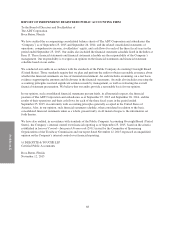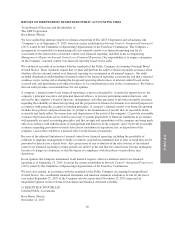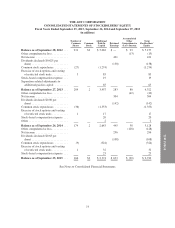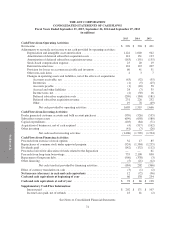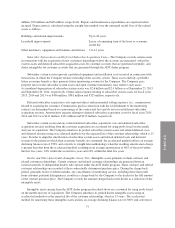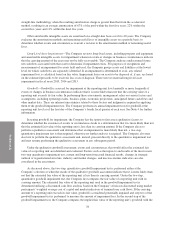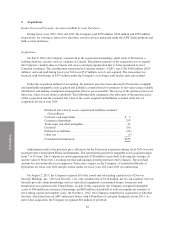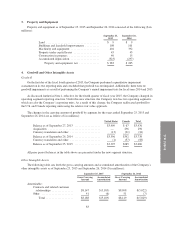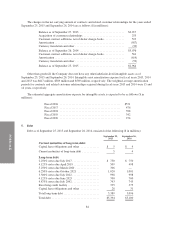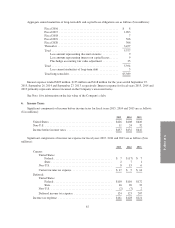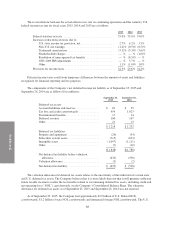ADT 2015 Annual Report Download - page 152
Download and view the complete annual report
Please find page 152 of the 2015 ADT annual report below. You can navigate through the pages in the report by either clicking on the pages listed below, or by using the keyword search tool below to find specific information within the annual report.
FORM 10-K
straight-line methodology when the resulting amortization charge is greater than that from the accelerated
method, resulting in an average amortization of 67% of the pool within the first five years, 22% within the
second five years and 11% within the final five years.
Other amortizable intangible assets are amortized on a straight-line basis over 6 to 40 years. The Company
evaluates the amortization methods and remaining useful lives of intangible assets on a periodic basis to
determine whether events and circumstances warrant a revision to the amortization method or remaining useful
lives.
Long-Lived Asset Impairments—The Company reviews long-lived assets, including property and equipment
and amortizable intangible assets, for impairment whenever events or changes in business circumstances indicate
that the carrying amount of the asset may not be fully recoverable. The Company analyzes undiscounted future
net cash flow associated with that asset to determine if impairment exists. For purposes of recognition and
measurement of an impairment for assets held and used, the Company groups assets and liabilities at the lowest
level for which cash flows are separately identified. If an impairment is determined to exist, any related
impairment loss is calculated based on fair value. Impairment losses on assets to be disposed of, if any, are based
on the estimated proceeds to be received, less costs of disposal. There were no material long-lived asset
impairments in fiscal years 2015, 2014 and 2013.
Goodwill—Goodwill is assessed for impairment at the reporting unit level annually or more frequently if
events or changes in business circumstances indicate that it is more likely than not that the carrying value of a
reporting unit exceeds its fair value. In performing these assessments, management relies on various factors and
assumptions, including operating results, business plans, economic projections, anticipated future cash flows and
other market data. There are inherent uncertainties related to these factors and judgment is required in applying
them to the goodwill impairment test. The Company performs its annual impairment tests for goodwill at the
reporting unit level as of the first day of the Company’s fourth fiscal quarter of each year. See Note 4 for further
information.
In testing goodwill for impairment, the Company has the option to first assess qualitative factors to
determine whether the existence of events or circumstances leads to a determination that it is more likely than not
that the estimated fair value of the reporting unit is less than its carrying amount. If the Company elects to
perform a qualitative assessment and determines that an impairment is more likely than not, a two-step,
quantitative impairment test is then required, otherwise no further analysis is required. The Company also may
elect not to perform the qualitative assessment and, instead, proceed directly to the quantitative impairment test
and may resume performing the qualitative assessment in any subsequent period.
Under the qualitative goodwill assessment, events and circumstances that would affect the estimated fair
value of a reporting unit are identified and evaluated. Factors such as the inputs to and results of the most recent
two-step quantitative impairment test, current and long-term forecasted financial results, changes in strategic
outlook or organizational structure, industry and market changes, and macroeconomic indicators are also
considered in the assessment.
As discussed above, the two-step, quantitative goodwill impairment test is performed either at the
Company’s election or when the results of the qualitative goodwill assessment indicate that it is more likely than
not that the estimated fair value of the reporting unit is less than its carrying amount. Under the two-step,
quantitative goodwill impairment test, the Company first compares the fair value of a reporting unit with its
carrying amount. The estimated fair value of the reporting unit used in the goodwill impairment test is
determined utilizing a discounted cash flow analysis based on the Company’s forecasts discounted using market
participants’ weighted average cost of capital and market indicators of terminal year cash flows. If the carrying
amount of a reporting unit exceeds its fair value, goodwill is considered potentially impaired and step two of the
goodwill impairment test is performed to measure the amount of impairment loss. In the second step of the
goodwill impairment test, the Company compares the implied fair value of the reporting unit’s goodwill with the
78


